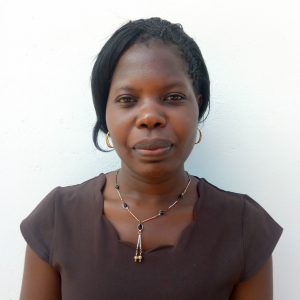Lutali A is a rural, peaceful area. Looking out across the village, it is highly vegetated with crops like maize, beans, sugarcane, and trees. Most buildings here are semi-permanent with smeared mud walls and floors; very few homes are made of cement.
There are 350 people in Lutali A who depend on Khavana Spring for water, but they face many challenges at this water point.
In its unprotected state, Khavana Spring is open and exposed to many contaminants thus making it unsafe for drinking. In an attempt to improve the spring's water quality, the community tried to backfill the area and inserted a discharge pipe into the ground. But without the proper materials or technical expertise of how to protect a spring, they fell short of their safe water goals. Surface runoff still pollutes the water, carrying farm chemicals, animal waste, and other contaminants. During the rainy season, the spring water turns brown due to the large amount of soil that gets washed into the water as well.
Community members spend a lot of time and money seeking medical treatment for their water-related illnesses. People here most commonly report cases of typhoid, diarrhea, and dysentery after drinking this spring water. Some community members have also lost their loved ones due to water-related diseases. But they have no other water source within walking distance they can turn to.
"We have been sick always as a family of typhoid, and l have spent a lot of money on treatment. Being sick always has caused me not to work so that l cannot provide for my family," explained 34-year-old farmer Benedict Shona.
While adults miss out on crucial productivity at home, at work, and on the farm while they are sick, kids miss their school lessons and fall behind.
"I have been sick always of stomach pain, thus making me be absent in school and not able to complete my homework in time," said local pupil, lvy.
Sometimes the money families owe for medical attention and medicine were intended for their children's school fees, and pupils cannot attend if their fees are not maintained. The students, consequently, fall further behind.
The village elder said if only their spring were protected, the community members and members from Nangavo Market, which is also nearby, will access clean and safe water and there will be no sicknesses caused by waterborne diseases. The community members would do their daily activities without any struggle, he added, improving their livelihoods, and thus becoming better people in their society.
What We Can Do:
Spring Protection
Protecting the spring will help provide access to cleaner and safer water and reduce the time people have to spend to fetch it. Construction will keep surface runoff and other contaminants out of the water. With the community’s high involvement in the process, there should be a good sense of responsibility and ownership for the new clean water source.
Fetching water is a task predominantly carried out by women and young girls. Protecting the spring and offering training and support will, therefore, help empower the female members of the community by freeing up more of their time and energy to engage and invest in income-generating activities and their education.
Training on Health, Hygiene, COVID-19, and More
To hold trainings during the pandemic, we work closely with both community leaders and the local government to approve small groups to attend training. We ask community leaders to invite a select yet representative group of people to attend training who will then act as ambassadors to the rest of the community to share what they learn. We also communicate our expectations of physical distancing and wearing masks for all who choose to attend.
The training will focus on improved hygiene, health, and sanitation habits in this community. We will also have a dedicated session on COVID-19 symptoms, transmission routes, and prevention best practices.
With the community’s input, we will identify key leverage points where they can alter their practices at the personal, household, and community levels to affect change. This training will help to ensure participants have the knowledge they need about healthy practices and their importance to make the most of their water point as soon as water is flowing.
Our team of facilitators will use a variety of methods to train community members. Some of these methods include participatory hygiene and sanitation transformation, asset-based community development, group discussions, handouts, and demonstrations at the spring.
One of the most important issues we plan to cover is the handling, storage, and treatment of water. Having a clean water source will be extremely helpful, but it is useless if water gets contaminated by the time it is consumed. We and the community strongly believe that all of these components will work together to improve living standards here, which will help to unlock the potential for these community members to live better, healthier lives.
We will then conduct a small series of follow-up trainings before transitioning to our regularly scheduled support visits throughout the year.
Training will result in the formation of a water user committee, elected by their peers, that will oversee the operations and maintenance of the spring. The committee will enforce proper behavior around the spring and delegate tasks that will help preserve the site, such as building a fence and digging proper drainage channels. The fence will keep out destructive animals and unwanted waste, and the drainage will keep the area’s mosquito population at a minimum.

 Protected Spring
Protected Spring
 Rehabilitation Project
Rehabilitation Project



































